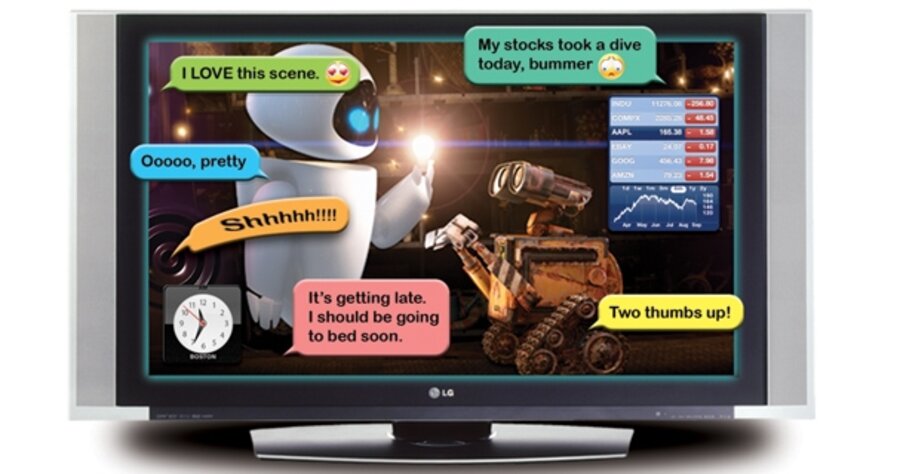Blu-ray and Yahoo inject the Web into television
Loading...
| Burbank, Calif.
Reclining on a couch, Disney executive Dave Hollis is proudly showing off the family room of the future. It’s not a theme-park Tomorrowland exhibit even though the chairs – marshmallow thrones, really – look like they belong on the bridge of Captain Picard’s Enterprise.
At the other end of the room, located in an office building, is a second-generation Blu-ray movie player that may fundamentally change the nature of home entertainment.
Today’s demonstration disc, an imminent rerelease of “Sleeping Beauty,” boasts a high-definition picture that makes traditional DVDs look as two-dimensional as a Mondrian painting. Yet its prime selling point is a Web-connected system called BD-Live that allows for multimedia interactivity.
For example, you can invite other households with Blu-ray players to watch the movie at the same time. The two players would automatically lock in sync, allowing viewers to send each other instant messages on the TV screen by typing on a Blackberry, laptop, or the remote control. Viewers also can compete in movie-related quizzes with others across the country. They can send and receive video messages that pop up as a picture-in-picture during the movie.
In short, the Blu-ray player turns your TV set into a social network built around a viewing experience.
“We’re hopeful that, as every studio develops and leverages the functionality of BD-Live, that we can make a very compelling argument for mom that it’s not too technical, and safe for her, and it’s something that really plays to the multitasking nature of her kids today,” says Mr. Hollis, whose title – senior vice president of worldwide product management – probably doesn’t fit onto a regular-size business card.
The way the entertainment industry sees it, tomorrow’s DVDs won’t be the only new form of interactive entertainment. Broadcast television will also include interactive features that go way beyond just selecting the camera angle on a football game. Film and TV companies believe the “Guitar Hero” generation, already accustomed to toggling between multiple applications online, will demand Web-connected elements that give them power over how they watch TV. The era of television as a passive medium may be about to end.
“The TV of tomorrow will absolutely include social networking,” says Tracy Swedlow, editor in chief of interactivetvtoday.com. “Instant messaging technology will be pervasive across all video platforms. I’m seeing people build applications that support Twitter [microblogging] across set-top boxes and the Internet. And, also, I’m seeing people develop applications that support Flickr, Facebook, and all the rest of those social-networking platforms.”
Late in August, Yahoo and Intel announced plans for the Widget Channel, a TV application that will bring Internet features to the television in 2009. The name is perhaps deceptive. It’s not really a channel, per se, but a ticker-shaped toolbar at the bottom of the screen with multiple miniapplications that can be expanded to sidebar size or to fill the entire screen.
The toolbar allows viewers to pull up a personalized interactive user interface overlaid on top of a broadcast program. It means you’ll be able watch “Antiques Roadshow” while an on-screen eBay widget keeps you appraised of your online auction bids. Fans of, say, the Discovery Channel or PBS’s Nova will be able to delve deeper into documentary subjects by accessing Wikipedia. And if you’re watching “CSI” and want to find out the name of the actor who has replaced William Petersen, you’ll be able to use your remote to log onto imdb.com without having to fire up your laptop. Once you’ve found out that the answer is Laurence Fishburne, you can click your Blockbuster widget and rent his films.
“We’re going to allow thousands of developers with great ideas and neat services to really go nuts and bring to bear their creativity,” says Patrick Barry, vice president of Connected TV at Yahoo. “I don’t think we even know what the killer apps are, yet.”
Mr. Barry says Yahoo wants its peers and competitors, as well as content companies and hardware manufacturers, to create an entire ecosystem.
Since the platform architecture happily incorporates most programming languages, it promises a low barrier to development.
Even so, there’s no guarantee that the Yahoo initiative will succeed. Competition for the interactive-television market is fierce – everyone from cable companies to Microsoft is vying to control it. After all, there’s great money to be made. Yahoo, for example, hopes to create a stock-price widget that links to its popular finance service. And an interface between television and Internet would also be the biggest thing to happen to the advertising industry since the first televised Super Bowl.
“You’re allowing the viewer to control the advertising environment,” observes Bruce Klopfenstein, a professor of new media at the University of Georgia in Athens. Interactive television also makes it easier to purchase things – especially impulse buys – by pointing a remote control at a product and using credit-card information stored on the system, says Dr. Klopfenstein.
The technology for such utilities already exists. But, to some, the notion of interactive entertainment ever taking off is pure hokum.
Phillip Swann, president and CEO of TV Predictions, was such a champion of interactive television that he wrote a book about it in 2000. Now, his faith in the medium has lapsed. He believes people will reject interactive TV because television is meant to be a passive medium.
“The whole point of television is to relax,” says Mr. Swann.
If he’s correct, girls won’t want to gossip during “Gossip Girl.” And they may not want an online chit-chat during “Sleeping Beauty.” But Disney, which has shown support for the Widget Channel, has a lot of money riding on the idea that movies and television are a natural medium for social-networking tools.
“There are a couple of generations now that have had technology influence their interaction with the media they consume,” says Hollis. “It’s not a function of when it will happen. It’s happening now.”






